Ok so I am very new to Java Swing and a beginner in Java in general. My current problem is I have designed a "cityscape". I am working on a UFO flying around, but my randomly generated buildings continue to get regenerated. I am wondering if there is a way to save my instance of buildings to an ArrayList as I have attempted, and paint that selection from that list each time paint is called. I tried what I thought of and I believe it just crashed it when run, because it didn't even open a JFrame and instead produced errors upon errors. Here is what I have:
CityScape class (the main class):
import java.awt.*;
import javax.swing.*;
public class CityScape extends JPanel
{
Buildings a = new Buildings ();
UFO b = new UFO();
@Override
public void paint (Graphics g)
{
//RememberBuildings.buildingList.get(1).paint(g);
a.paint(g);
b.paint(g);
}
public void move()
{
b.move();
}
public static void main(String[] args) throws InterruptedException
{
JFrame frame = new JFrame("Frame");
CityScape jpe = new CityScape();
frame.add(jpe);
frame.setSize(800, 750);
frame.setBackground(Color.BLACK);
frame.setLocationRelativeTo(null);
frame.setVisible(true);
frame.setDefaultCloseOperation(JFrame.EXIT_ON_CLOSE);
System.out.println(frame.getContentPane().getSize());
while (true)
{
jpe.move(); //Updates the coordinates
jpe.repaint(); //Calls the paint method
Thread.sleep(10); //Pauses for a moment
}
}
}
Buildings class (the class that generates the buildings):
import java.awt.*;
public class Buildings
{
private int maxX = 784;
private int maxY = 712;
private int width = (int)(Math.random()*100+100);
private int height = (int)(Math.random()*350+100);
private int rows = Math.round((height)/25);
private int columns = Math.round(width/25);
public void addBuilding()
{
RememberBuildings.addBuilding();
}
public void paint(Graphics g)
{
Graphics2D g2d = (Graphics2D) g;
Color transYellow = new Color (255, 255, 0, 59);
g2d.setColor(Color.BLACK);
g2d.fillRect(0, 0, maxX, maxY);
g2d.setColor(Color.WHITE);
g2d.fillRect(5, 5, 25, 25);
int a = 0;
for (int i =10; i<634; i+=(a+10))//buildings
{
g2d.setColor(Color.GRAY);
g2d.drawRect(i, maxY-height, width, height);
g2d.fillRect(i, maxY-height, width, height);
rows = Math.round((height)/25);
columns = Math.round(width/25);
for (int j = 1; j<=columns; j++)//windows
{
for (int k = 1; k<=rows; k++)
{
g2d.setColor(Color.BLACK);
g2d.drawRect(i+5*j+20*(j-1), (maxY-height)+5*k+20*(k-1), 20, 20);
if (Math.random()<0.7)
{
g2d.setColor(Color.YELLOW);
g2d.fillRect(i+5*j+20*(j-1), (maxY-height)+5*k+20*(k-1), 20, 20);
}
else
{
g2d.setColor(Color.BLACK);
g2d.fillRect(i+5*j+20*(j-1), (maxY-height)+5*k+20*(k-1), 20, 20);
g2d.setColor(transYellow);
g2d.fillRect(i+5*j+20*(j-1), (maxY-height)+5*k+20*(k-1), 20, 20);
}
}
}
addBuilding();
a = width;
height = (int)(Math.random()*462+100);
width = (int)(Math.random()*100+100);
}
}
}
RememberBuildings class (the point of this is to add an instance to an ArrayList):
import java.util.*;
public class RememberBuildings
{
public static ArrayList<Buildings> buildingList = new ArrayList<Buildings>();
public static void addBuilding()
{
buildingList.add(new Buildings());
}
}
And finally my UFO class (creates the UFO flying by):
import java.awt.*;
import javax.swing.*;
public class UFO extends JPanel
{
private int x = 20; //x and y coordinates of the ball
private int y = 20;
private int xa = 1;
public void move() //Increase both the x and y coordinates
{
if (x + xa < 0) {
xa = 1;
}
if (x + xa > 784-75)
{
xa = -1;
}
x = x + xa;
}
public void paint(Graphics g)
{
super.paint(g); //Clears the panel, for a fresh start
Graphics2D g2d = (Graphics2D) g;
g2d.setColor(Color.LIGHT_GRAY);
g2d.fillOval(x,y,75,25); //Draw the ball at the desired point
}
}

